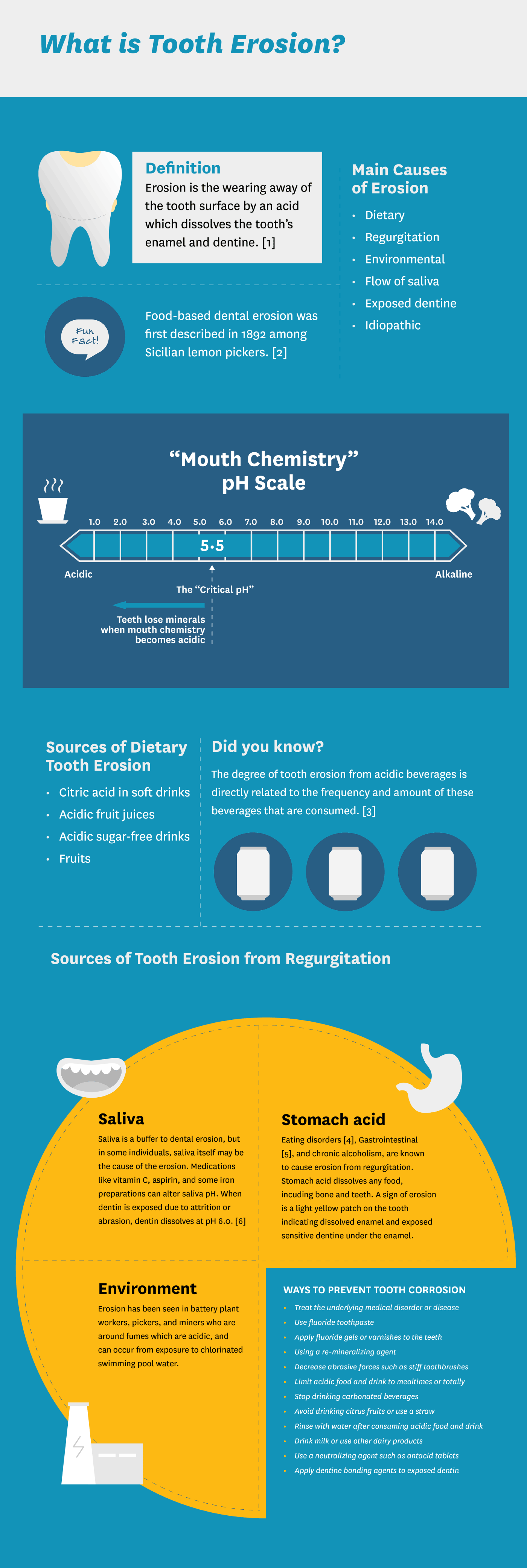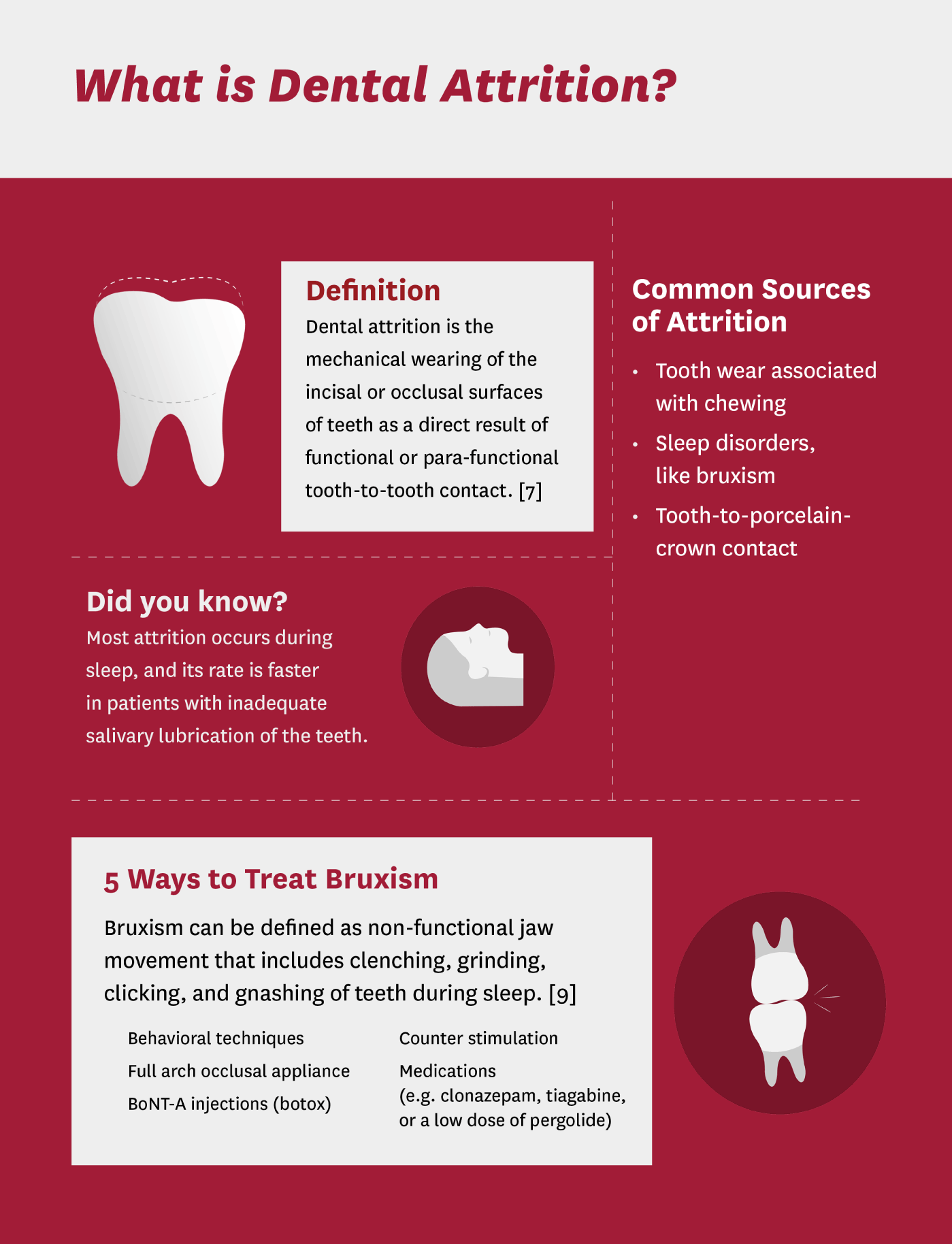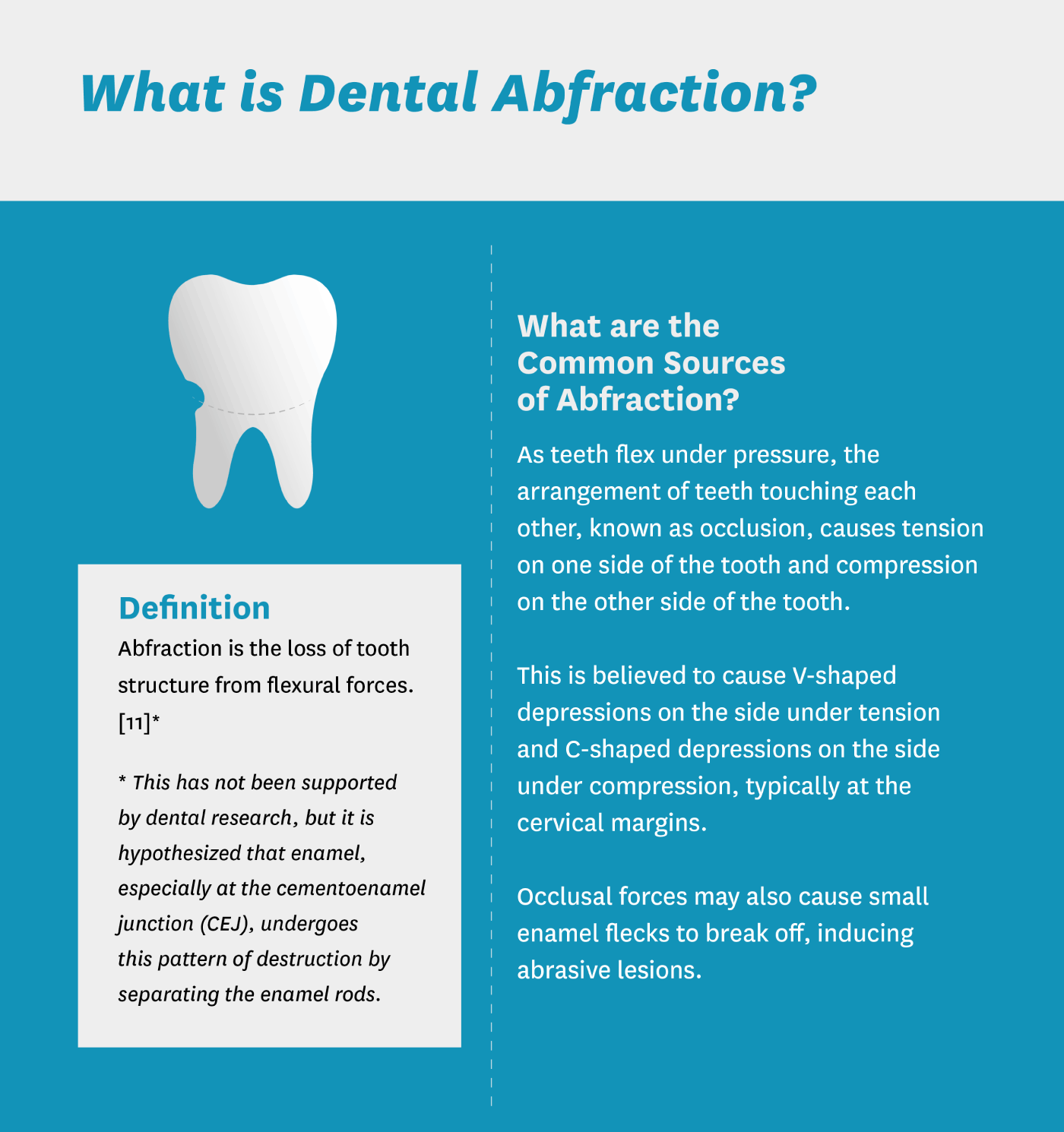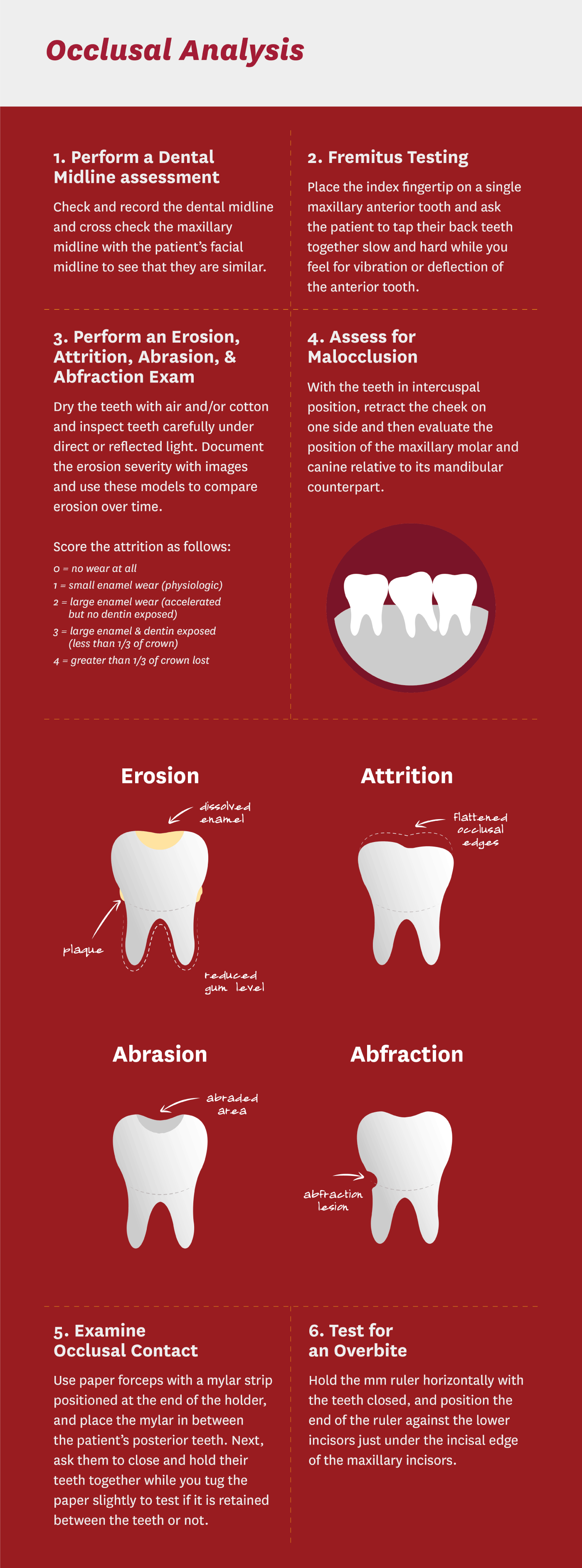Learn how to diagnose, monitor, and treat different types of tooth wear including erosion, attrition, abrasion, and abfraction with this infographic based on Dr. Glenn Clark’s course on abnormal oral physiology and sensory disorders.
Want a full copy of the infographic? Download the infographic for free!

What is tooth erosion?
Tooth erosion is the wearing away of the tooth surface by an acid, which dissolves the enamel and dentine. There are six primary causes of erosion: dietary, regurgitation, environmental, the flow of saliva, exposed dentin, and idiopathic.
Dietary sources of erosion include carbonated beverages, fruit juice, and fruit. Regurgitation sources include gastroesophageal reflux disease and eating disorders like anorexia and bulimia.
Dentists should document the severity of erosion with pictures and periodically use these models to compare erosion over time.

What is dental attrition?
Dental attrition is the wearing of the incisal or occlusal surfaces of teeth as a result of functional or parafunctional tooth-to-tooth contact. Regular attrition is slow tooth wear associated with chewing.
Sleep disorders like bruxism cause more significant tooth wear. Porcelain crowns can also wear down natural teeth. Lubrication is also indicative of the severity of dental attrition; a greater force and inadequate lubrication produce more attrition.

What is dental abrasion?
Dental abrasion is tooth wear originating from friction or mechanical forces from a foreign object, and it predominantly impacts premolars and canines. Tooth wear from abrasion typically looks like a wedge or V-shaped indentation of the tooth at the gum margin, and it appears worn, shiny and is often discolored at the cervical margin.
Some causes of abrasion include rough, lateral tooth brushing, biting your nails, chewing on pens, pipe smoking, placing and removing denture clasps, abrasive dentifrices, and stiff toothbrushes. Toothbrush abrasion can be repaired by bonding a tooth-colored filling over the abraded area of the tooth.

What is dental abfraction?
Abfraction is tooth wear from flexural forces, but it has not been supported by dental research.
When teeth flex under pressure, they touch each other (occlusion), creating tension on one side (v-shaped depressions) and compression (C-shaped depressions) on the other side of the tooth. Researchers believe enamel, especially at the cementoenamel junction (CEJ), undergo this pattern of destruction by separating the enamel rods.

How to Perform an Occlusal Analysis
Occlusion, simply defined, is how teeth meet when the lower and upper jaw come together. Proper occlusion is necessary for eating, aesthetics, and disease prevention. However, many factors can cause malocclusion including trauma and genetics.
Six Steps for Performing an Occlusal Analysis
- Dental Midline Assessment
- Fremitus Testing
- Erosion, Attrition, Abrasion, and Abfraction Exam
- Malocclusion
- Occlusal Contact
- Overbite/Overjet Assessment
Erosion, Attrition, Abrasion, and Abfraction Exam
The severity of erosion can be measured comparing pictures of teeth over time. Attrition can be scored as follows:
- 0 = no wear at all
- 1 = small enamel wear (physiologic)
- 2 = large enamel wear (accelerated but no dentin exposed)
- 3 = large enamel & dentin exposed (less than 1/3 of crown)
- 4 = greater than 1/3 of crown lost
Abrasion typically looks like a wedge or V-shaped indentation of the tooth at the gum margin, and it appears worn, shiny and is often discolored at the cervical margin. Although it has not been supported by research, abfraction may appear as v-shaped depressions on one side of the teeth and C-shaped depressions on the other side.
Embed the Full Infographic on your Website
Want to publish the full infographic on your website? Click on the button to copy the embed code to your clipboard:
[copy tag=”button” text=”Copy the Embed Code” copied-text=”Embed Code Successfully Copied”]<a href=”https://ostrowonline.usc.edu/2021/03/04/dental-erosion-attrition-abrasion-abfraction/”><img style=”width:100%;” src=”https://ostrowonline.usc.edu/wp-content/uploads/2021/03/tooth-erosion-attrition-abrasion-abfraction-infographic-usc-ostrow-online-postgraduate-dentistry-programs.png”></a><br>Infographic courtesy of the Herman Ostrow School of Dentistry of USC’s Online Programs <a href=”https://ostrowonline.usc.edu”>Herman Ostrow School of Dentistry of USC’s Online Programs</a>[/copy]
Not working? Copy the raw code here:
<a href="https://ostrowonline.usc.edu/2021/03/04/dental-erosion-attrition-abrasion-abfraction/"><img style="width:100%;" src="https://ostrowonline.usc.edu/wp-content/uploads/2021/03/tooth-erosion-attrition-abrasion-abfraction-infographic-usc-ostrow-online-postgraduate-dentistry-programs.png"></a><br>Infographic courtesy of the Herman Ostrow School of Dentistry of USC's Online Programs <a href="https://ostrowonline.usc.edu">Herman Ostrow School of Dentistry of USC's Online Programs</a>
Want a full copy of the infographic? Download the infographic for free!
Earn an Online Postgraduate Degree in Orofacial Pain and Oral Medicine
Are you interested in a variety of issues focused on orofacial pain, medicine and sleep disorders? Consider enrolling in the Herman Ostrow School of Dentistry of USC’s online, competency-based certificate or master’s program in Orofacial Pain and Oral Medicine.
References
- The Herman Ostrow School of Dentistry of USC. What is Tooth Erosion? Causes, Diagnosis, and Treatment. August 1, 2019.
- West Indian Med J. Dental Erosion and Medical Conditions An Overview of Aetiology, Diagnosis and Management. 2014 Sep; 63(5): 499–502.
- PLoS One. Influence of Various Acidic Beverages on Tooth Erosion. Evaluation by a New Method. 2015; 10(6): e0129462.
- PLoS One. Tooth Erosion and Eating Disorders: A Systematic Review and Meta-Analysis. 2014; 9(11): e111123.
- Int J Dent. Gastroesophageal Reflux Disease and Tooth Erosion. 2012; 2012: 479850.
- J Appl Oral Sci. Saliva and Dental Erosion. 2012 Sep-Oct; 20(5): 493–502.
- The Herman Ostrow School of Dentistry of USC. What is dental attrition? August 6th, 2019.
- Scandinavian Journal of Dental Research. Covariation of some factors associated with occlusal tooth wear in a selected high-wear sample. January 1994. 101(6):398-406.
- The Herman Ostrow School of Dentistry of USC. 5 Ways to Treat Bruxism. February 24th, 2020.
- The Herman Ostrow School of Dentistry of USC. Dental Erosion from Abrasion & Abfraction. August 8th, 2019.
- The Herman Ostrow School of Dentistry of USC. The Dentist’s Guide: Tooth Erosion, Attrition, Abrasion, and Abfraction. November 28th, 2019.
- The Herman Ostrow School of Dentistry of USC. How to Perform an Occlusal Analysis. July 21, 2020.

